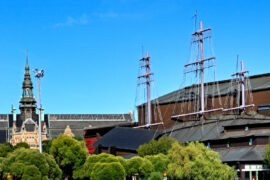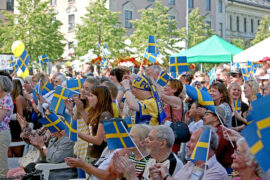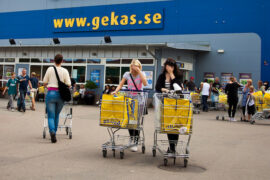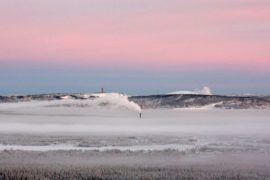For most Europeans, the difference between Sweden and Switzerland is obvious. They are two separate countries, each with their own government, culture and language.

Sweden is a land of lakes, forests, wide-open spaces and moose roaming wild, while Switzerland is chocolate-box pretty with snow-capped mountains, flower-strewn villages and mountain goats!
So questions such as “Are Sweden and Switzerland the same?” can seem rather odd.
If you’ve visited either country, or even done a bit of basic research, it’s as simple as chocolate, cheese and cuckoo clocks versus Abba, Ikea and meatballs!
But, there are similarities between the two countries – both are beautiful, affluent and sometimes snowy – and there’s no reason why anyone outside these two relatively small countries should know the differences between them.

So, follow along as we clear up a few commonly asked questions such as “Is a Swede from Switzerland?” and “Is Swedish and Swiss the same thing?”.
Is Sweden the same as Switzerland?
First of all, let’s clear up the knotty question of “Is Sweden in Switzerland?’ And the answer is most definitely… no.
If we look at Sweden vs Switzerland on a map, we can see that Sweden lies in northern Europe, and Switzerland is around 1600km away in central Europe.
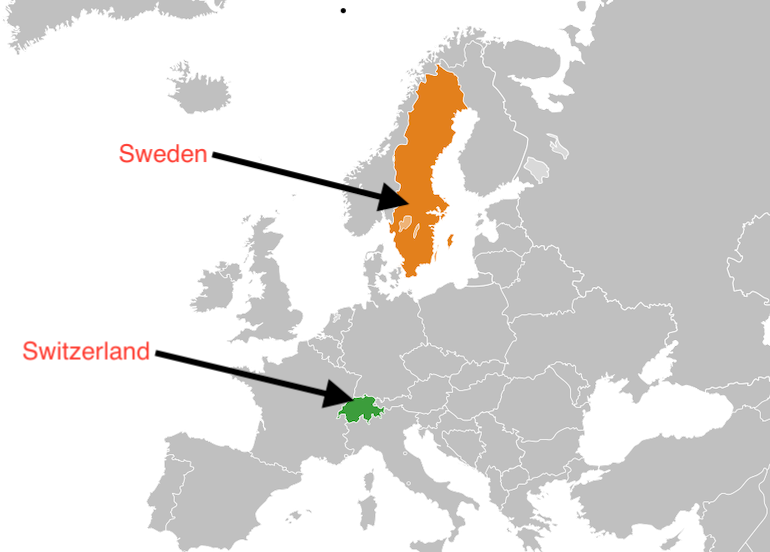
Sweden is in the northern European landmass known as Scandinavia – for more on this, see our quick guide to Scandinavia – while Switzerland is nestled in the Alps, pretty much in the centre of Europe.
And the capital of Switzerland is Bern (though it’s actually only the country’s fourth largest city, after the better-known cities of Zurich, Geneva and Basle), while Sweden’s capital city is Stockholm.
Are the Swiss from Sweden or Switzerland?
Ok, let’s get this straight: if you’re from Switzerland, you’re Swiss. And if you’re from Sweden, you’re a Swede – not to be confused with the root vegetable of the same name!
Also, if you’re from Sweden, your culture and your language is Swedish. If you’re from Switzerland, your culture is Swiss, but you don’t speak Swiss as there is no such thing as the Swiss language.
Confusing? Yes, but we’ll get onto that in more detail below.
Do Sweden and Switzerland speak the same language?
People in Sweden speak Swedish, a Nordic language that derives from Old Norse, with Germanic influences. For more on the Swedish language, see our posts on the Swedish alphabet and how many people speak Swedish.
As for people in Switzerland, well, they speak any one of four languages depending on which part of the country they live in. Switzerland’s four official languages are German, French, Italian and Romansch.
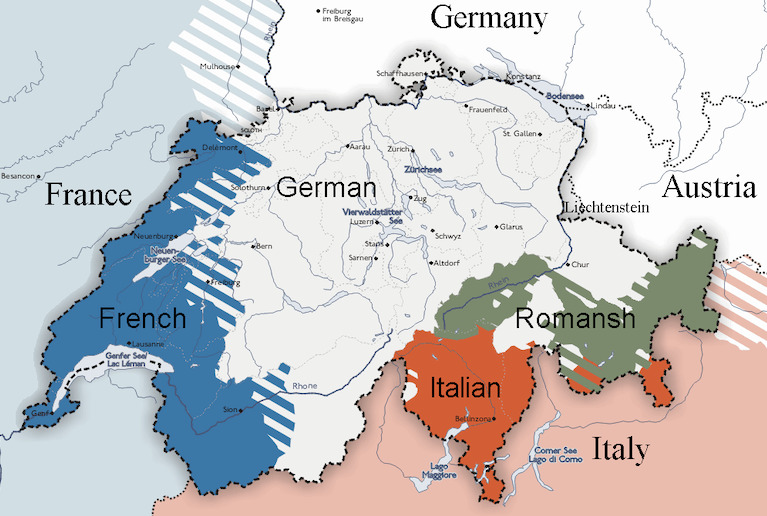
Swiss German (a local variant of German) is the most widely spoken language (about 60 percent of the population speak it), followed by French (spoken by about 22 percent), then Italian (around 8 percent).
Just 0.5 percent of the Swiss population speak Romansch, a Rhaeto-Romanic language derived from Latin.
Some areas of Switzerland are officially bilingual, while the canton (district) of Graubünden is even trilingual. So as a visitor, you can ‘tri’ any of the three spoken languages!
Many Swiss are likely to speak at least one of these languages – in fact, more than two thirds of Swiss adults regularly speak more than one language.
However, there is one language that both the Swiss and Swedish have in common – and that’s English.
Around 45 percent of Swiss people speak English regularly – and it has even become the de facto official language in some cases – while an astonishing 85 percent of Swedes can speak conversational or fluent English.
Sweden vs Switzerland: which is bigger?
Sweden is more than ten times bigger than Switzerland, covering an area of 447,430 sq km, compared to Switzerland’s 41,285 sq km. Switzerland has a population of 8.6 million, compared to Sweden, with 10.4 million people.
So, Sweden has a much lower population density with around 25 people per square kilometre compared to Switzerland’s 219 people per square kilometre.
Swiss vs Swedish: geography
The geography of the two countries is quite different, too. Switzerland is a small landlocked country with no coastline and plenty of mountains. In fact, some 60 percent of the country lies within the Alps and a further 11 percent in the Jura mountain range.
Sweden is a much larger country – Europe’s fourth biggest – and its coastline stretches for 3218km. It’s also got more islands than another country in the world – a staggering 220,000 of them! – and around 100,000 lakes.
Sweden has land borders with just two other countries – Norway and Finland – while Switzerland’s neighbours are France, Germany, Austria, Italy and the tiny principality of Liechtenstein.
Swiss franc vs Swedish krona: what’s the difference?
The currency of Switzerland is the Swiss franc, and the currency of Sweden is the Swedish krona.
Although both countries are in Europe, Sweden is in the EU and the EEA (European Economic Area), while Switzerland is not a member of either. It is however in the European single market.
And whilst Sweden is a full member of the EU, it has not adopted the euro as its currency but has retained the Swedish krona.
Sweden vs Switzerland: cost of living
The cost of living in both Sweden and Switzerland is relatively high. However, Switzerland definitely beats Sweden here, regularly ranking in the top ten of the most expensive countries in the world in which to live.
A recent survey put Switzerland as the third most expensive country in the world (topped only by Monaco and the Cayman Islands), with Sweden at 27th.
Switzerland’s GDP per capita is a whopping US$95,000 (the sixth highest in the world), compared to Sweden at around US$59,000.
There’s more on the cost of living in Sweden here.
Sweden vs Switzerland: quality of life
As affluent developed western European countries, both Sweden and Switzerland offer their citizens a good quality of life.
Both have low crime rates (though an increase in gun crime and gang violence has put Sweden’s rate higher than one might expect), good healthcare, good education systems and high rates of life expectancy.
Switzerland ranks higher than Sweden in most quality of life indexes, but only just and Sweden certainly beats it in population density having far more open space per person than Switzerland.
Swiss flag vs Swedish flag
So, let’s look at the two countries’ flags. Switzerland’s may be more familiar, due to its similarity to the international Red Cross charity emblem.
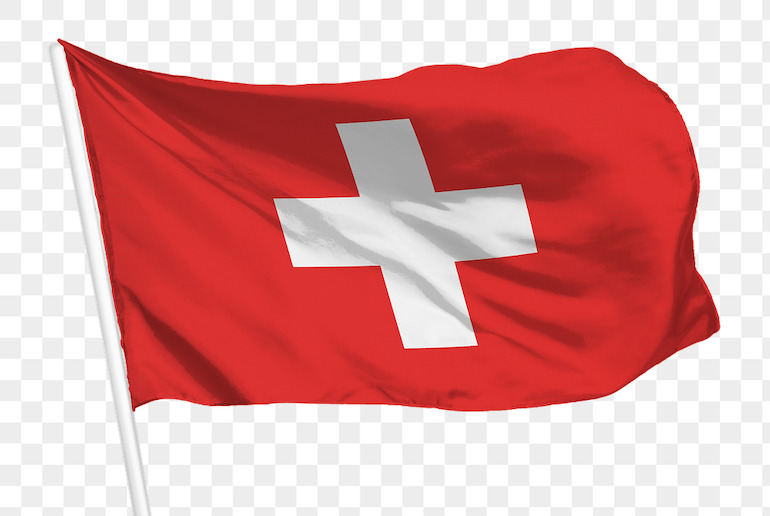
In fact, the Red Cross was founded under the Geneva Convention and took its symbol from the Swiss flag, simply inverting the colours from the Swiss white cross on a red background to a red cross on a white background.
Unusually, the Swiss flag is square – the only country in the world to have a square flag other than The Vatican.
The Swedish flag also features a cross, but it has a yellow Nordic cross on a blue background. For more on the Swedish flag and its origins, read All you need to know about Scandinavian flags.
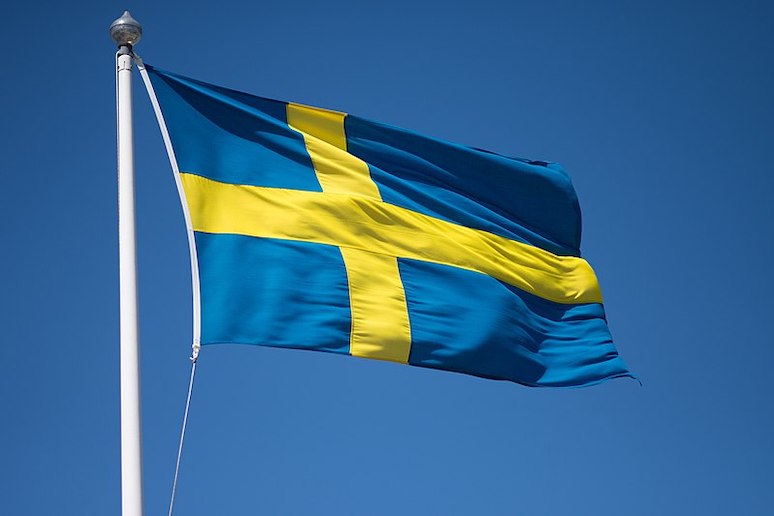
Swiss kriss vs Swedish bitters
So you may have both these in your medicine cabinet if you suffer from stomach problems.
Both contain powdered senna leaves, but Swiss kriss is a herbal laxative while Swedish bitters is a traditional tonic that has been used to aid digestion since the 17th century.
Swiss vs Swedish people
Clearly it’s difficult to generalise about the citizens of any country and their personalities, but we can look at characteristics and traits that they may have in common.
Politically, for example, the Swedish tend to be more liberal and progressive than the Swiss, with a more open-minded attitude to life. The Swiss are more conservative and have an (unfair) reputation for secrecy – in particular in relation to their bank accounts!
The Swiss are known for their punctuality and strong work ethic, while the Swedes (who are also fans of being on time) tend to have a more laid-back family-centric view of life.
Both nationalities, however, are known for their eco-credentials, with Switzerland producing around 75 percent of its energy from renewables and Sweden about 52 percent.
In fact, in the 2022 Environmental Performance Index, Switzerland came top as the world’s greenest country, with Sweden in fifth place.
See also:
Danish vs Dutch: what is the difference?
Where is Danish spoken?
Nordic vs Scandinavian: what’s the difference?


